Analysis of Apple's Organizational Structure Report
VerifiedAdded on 2022/12/26
|9
|2407
|67
Report
AI Summary
This report offers a comprehensive analysis of Apple's organizational structure, examining the factors that influence it, the characteristics of its divisional and functional matrix structures, and the dynamic processes that shape its growth and evolution. The report begins by defining organizational theory and exploring various organizational structures, highlighting their application in the context of Apple. It then identifies and analyzes key factors affecting Apple's organizational structure, including its organizational strategy, technological advancements, workforce dynamics, the electronic industry, and leadership. The report further delves into the characteristics of divisional and functional matrix structures within Apple, comparing and contrasting them. Finally, it explains how Apple manages the dynamic processes of organizational culture, leadership, innovation, and creativity to foster continuous growth and evolution. The report concludes by summarizing the key findings and emphasizing the significance of organizational structure in achieving business success.
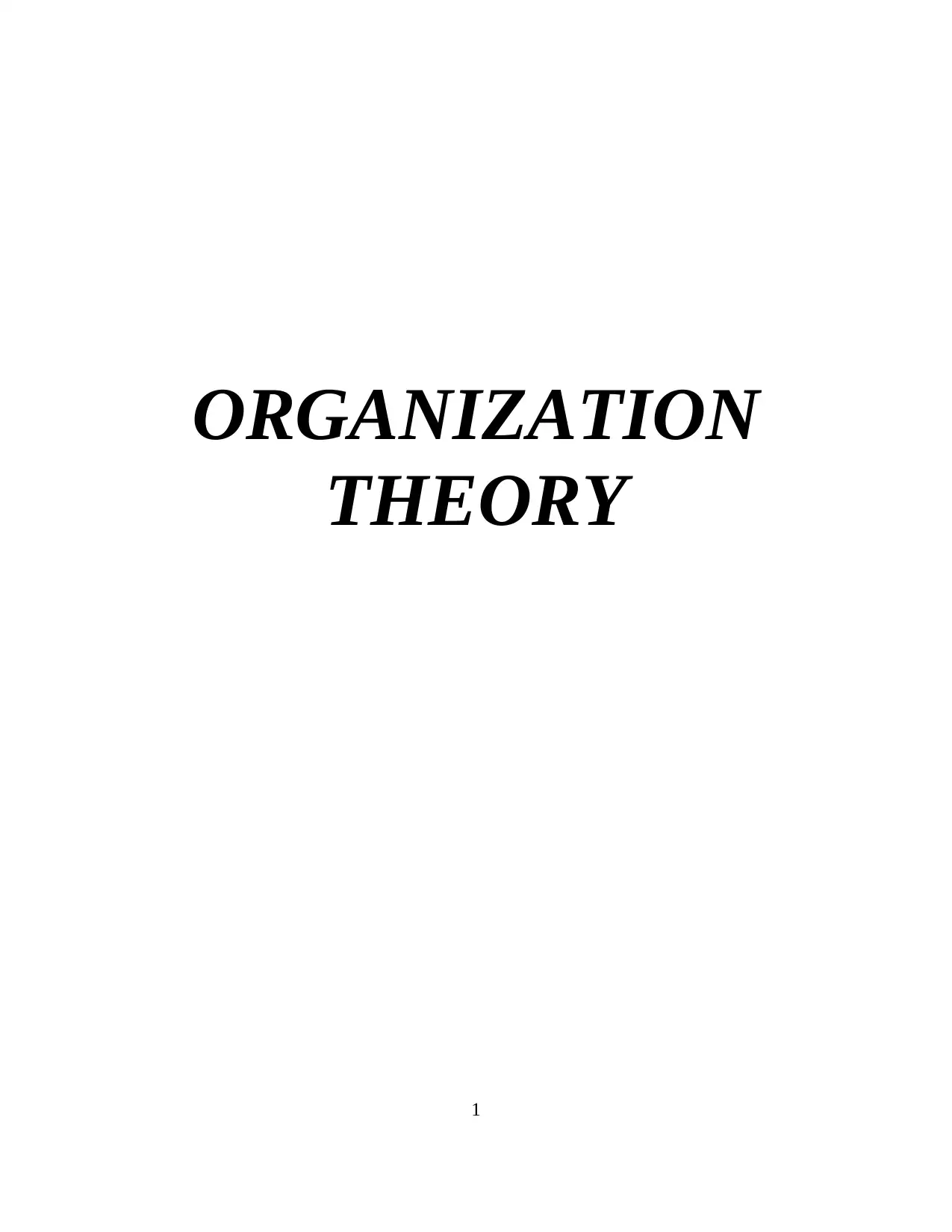
ORGANIZATION
THEORY
1
THEORY
1
Paraphrase This Document
Need a fresh take? Get an instant paraphrase of this document with our AI Paraphraser
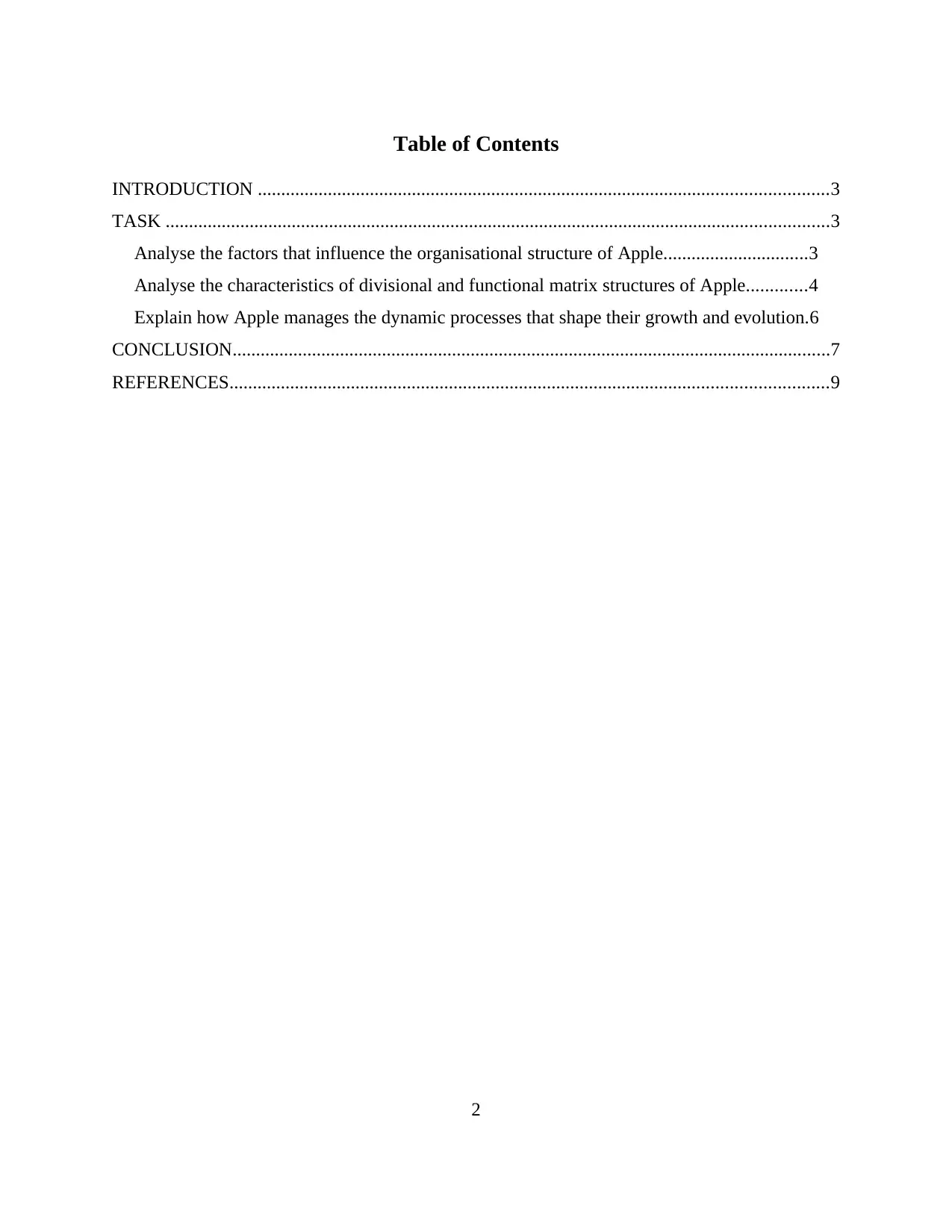
Table of Contents
INTRODUCTION ..........................................................................................................................3
TASK ..............................................................................................................................................3
Analyse the factors that influence the organisational structure of Apple...............................3
Analyse the characteristics of divisional and functional matrix structures of Apple.............4
Explain how Apple manages the dynamic processes that shape their growth and evolution.6
CONCLUSION................................................................................................................................7
REFERENCES................................................................................................................................9
2
INTRODUCTION ..........................................................................................................................3
TASK ..............................................................................................................................................3
Analyse the factors that influence the organisational structure of Apple...............................3
Analyse the characteristics of divisional and functional matrix structures of Apple.............4
Explain how Apple manages the dynamic processes that shape their growth and evolution.6
CONCLUSION................................................................................................................................7
REFERENCES................................................................................................................................9
2
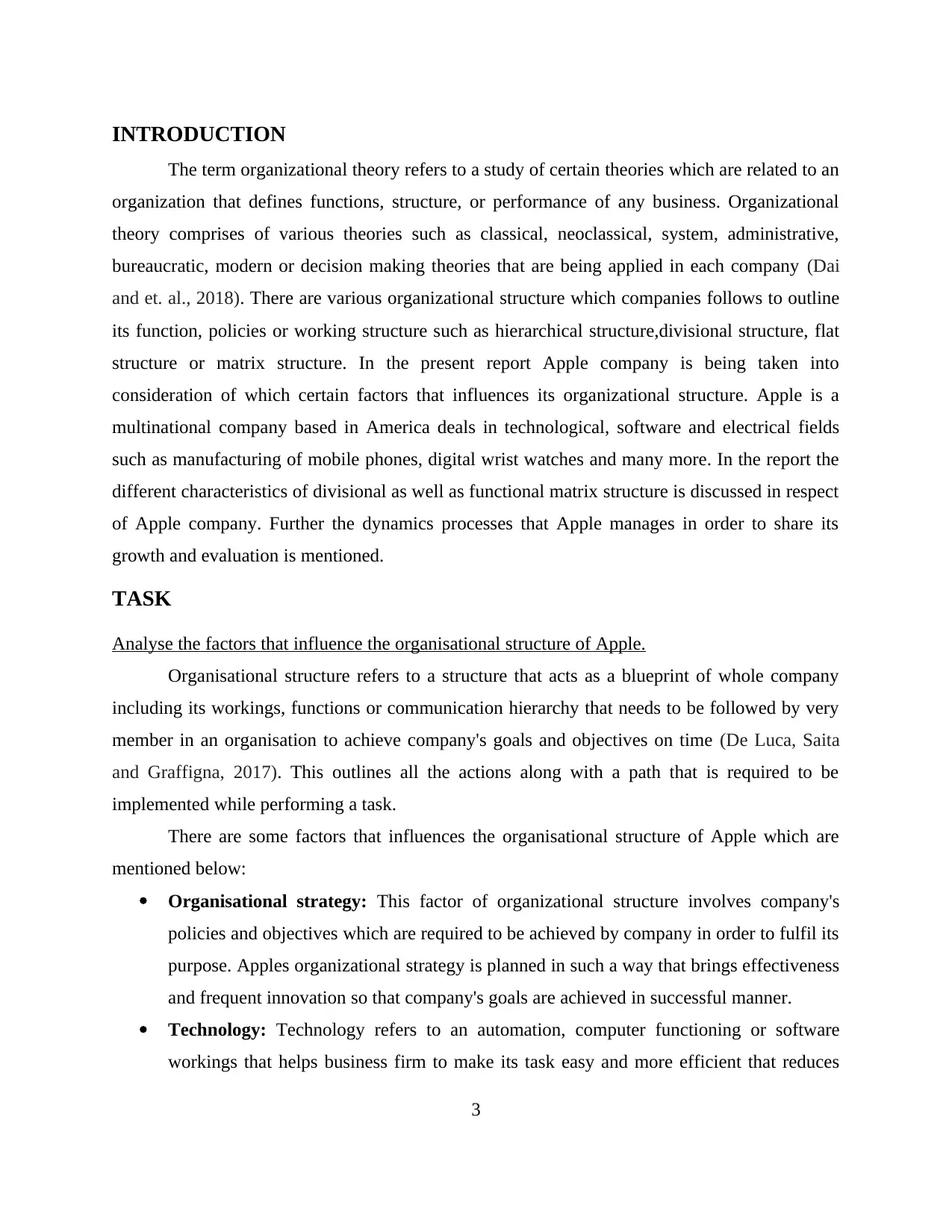
INTRODUCTION
The term organizational theory refers to a study of certain theories which are related to an
organization that defines functions, structure, or performance of any business. Organizational
theory comprises of various theories such as classical, neoclassical, system, administrative,
bureaucratic, modern or decision making theories that are being applied in each company (Dai
and et. al., 2018). There are various organizational structure which companies follows to outline
its function, policies or working structure such as hierarchical structure,divisional structure, flat
structure or matrix structure. In the present report Apple company is being taken into
consideration of which certain factors that influences its organizational structure. Apple is a
multinational company based in America deals in technological, software and electrical fields
such as manufacturing of mobile phones, digital wrist watches and many more. In the report the
different characteristics of divisional as well as functional matrix structure is discussed in respect
of Apple company. Further the dynamics processes that Apple manages in order to share its
growth and evaluation is mentioned.
TASK
Analyse the factors that influence the organisational structure of Apple.
Organisational structure refers to a structure that acts as a blueprint of whole company
including its workings, functions or communication hierarchy that needs to be followed by very
member in an organisation to achieve company's goals and objectives on time (De Luca, Saita
and Graffigna, 2017). This outlines all the actions along with a path that is required to be
implemented while performing a task.
There are some factors that influences the organisational structure of Apple which are
mentioned below:
Organisational strategy: This factor of organizational structure involves company's
policies and objectives which are required to be achieved by company in order to fulfil its
purpose. Apples organizational strategy is planned in such a way that brings effectiveness
and frequent innovation so that company's goals are achieved in successful manner.
Technology: Technology refers to an automation, computer functioning or software
workings that helps business firm to make its task easy and more efficient that reduces
3
The term organizational theory refers to a study of certain theories which are related to an
organization that defines functions, structure, or performance of any business. Organizational
theory comprises of various theories such as classical, neoclassical, system, administrative,
bureaucratic, modern or decision making theories that are being applied in each company (Dai
and et. al., 2018). There are various organizational structure which companies follows to outline
its function, policies or working structure such as hierarchical structure,divisional structure, flat
structure or matrix structure. In the present report Apple company is being taken into
consideration of which certain factors that influences its organizational structure. Apple is a
multinational company based in America deals in technological, software and electrical fields
such as manufacturing of mobile phones, digital wrist watches and many more. In the report the
different characteristics of divisional as well as functional matrix structure is discussed in respect
of Apple company. Further the dynamics processes that Apple manages in order to share its
growth and evaluation is mentioned.
TASK
Analyse the factors that influence the organisational structure of Apple.
Organisational structure refers to a structure that acts as a blueprint of whole company
including its workings, functions or communication hierarchy that needs to be followed by very
member in an organisation to achieve company's goals and objectives on time (De Luca, Saita
and Graffigna, 2017). This outlines all the actions along with a path that is required to be
implemented while performing a task.
There are some factors that influences the organisational structure of Apple which are
mentioned below:
Organisational strategy: This factor of organizational structure involves company's
policies and objectives which are required to be achieved by company in order to fulfil its
purpose. Apples organizational strategy is planned in such a way that brings effectiveness
and frequent innovation so that company's goals are achieved in successful manner.
Technology: Technology refers to an automation, computer functioning or software
workings that helps business firm to make its task easy and more efficient that reduces
3
⊘ This is a preview!⊘
Do you want full access?
Subscribe today to unlock all pages.

Trusted by 1+ million students worldwide
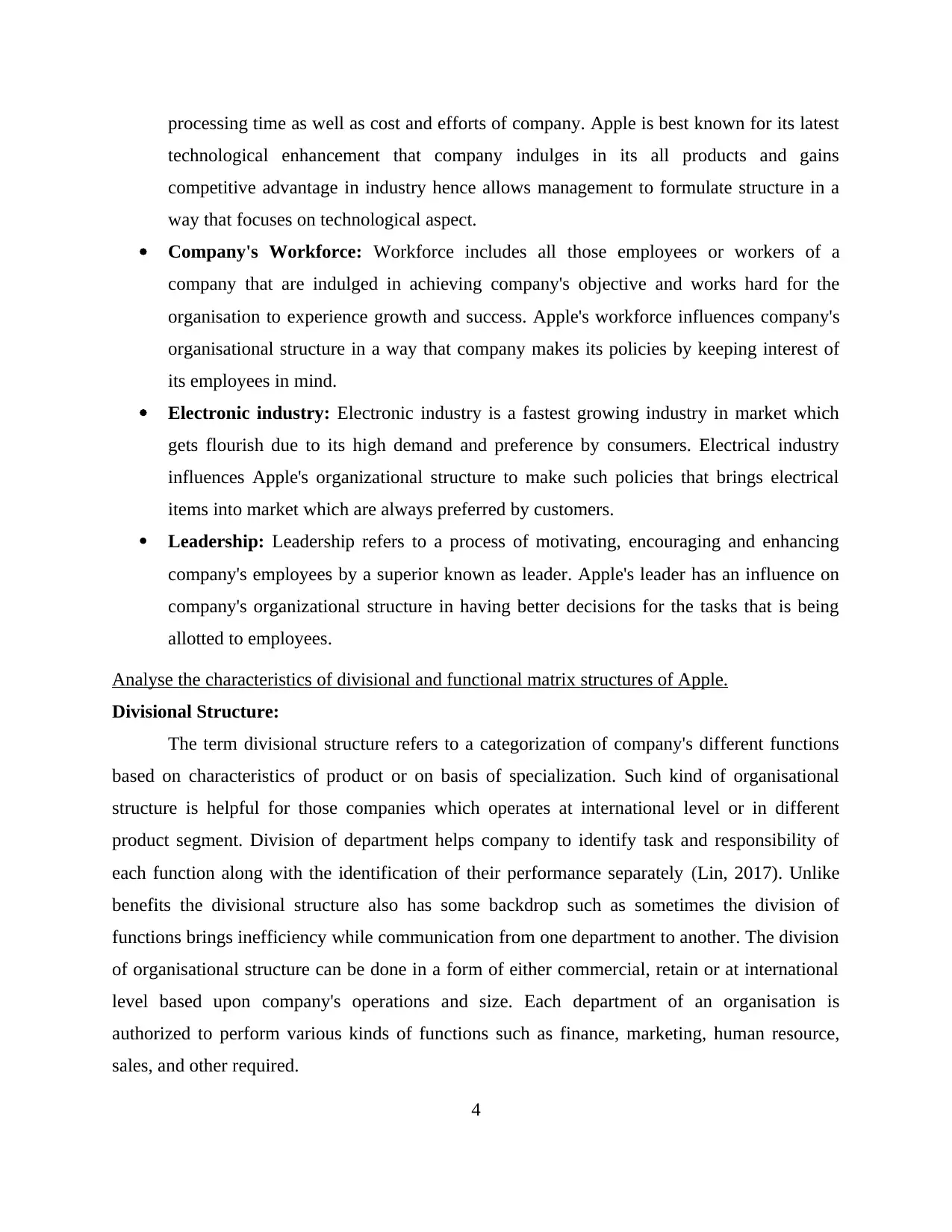
processing time as well as cost and efforts of company. Apple is best known for its latest
technological enhancement that company indulges in its all products and gains
competitive advantage in industry hence allows management to formulate structure in a
way that focuses on technological aspect.
Company's Workforce: Workforce includes all those employees or workers of a
company that are indulged in achieving company's objective and works hard for the
organisation to experience growth and success. Apple's workforce influences company's
organisational structure in a way that company makes its policies by keeping interest of
its employees in mind.
Electronic industry: Electronic industry is a fastest growing industry in market which
gets flourish due to its high demand and preference by consumers. Electrical industry
influences Apple's organizational structure to make such policies that brings electrical
items into market which are always preferred by customers.
Leadership: Leadership refers to a process of motivating, encouraging and enhancing
company's employees by a superior known as leader. Apple's leader has an influence on
company's organizational structure in having better decisions for the tasks that is being
allotted to employees.
Analyse the characteristics of divisional and functional matrix structures of Apple.
Divisional Structure:
The term divisional structure refers to a categorization of company's different functions
based on characteristics of product or on basis of specialization. Such kind of organisational
structure is helpful for those companies which operates at international level or in different
product segment. Division of department helps company to identify task and responsibility of
each function along with the identification of their performance separately (Lin, 2017). Unlike
benefits the divisional structure also has some backdrop such as sometimes the division of
functions brings inefficiency while communication from one department to another. The division
of organisational structure can be done in a form of either commercial, retain or at international
level based upon company's operations and size. Each department of an organisation is
authorized to perform various kinds of functions such as finance, marketing, human resource,
sales, and other required.
4
technological enhancement that company indulges in its all products and gains
competitive advantage in industry hence allows management to formulate structure in a
way that focuses on technological aspect.
Company's Workforce: Workforce includes all those employees or workers of a
company that are indulged in achieving company's objective and works hard for the
organisation to experience growth and success. Apple's workforce influences company's
organisational structure in a way that company makes its policies by keeping interest of
its employees in mind.
Electronic industry: Electronic industry is a fastest growing industry in market which
gets flourish due to its high demand and preference by consumers. Electrical industry
influences Apple's organizational structure to make such policies that brings electrical
items into market which are always preferred by customers.
Leadership: Leadership refers to a process of motivating, encouraging and enhancing
company's employees by a superior known as leader. Apple's leader has an influence on
company's organizational structure in having better decisions for the tasks that is being
allotted to employees.
Analyse the characteristics of divisional and functional matrix structures of Apple.
Divisional Structure:
The term divisional structure refers to a categorization of company's different functions
based on characteristics of product or on basis of specialization. Such kind of organisational
structure is helpful for those companies which operates at international level or in different
product segment. Division of department helps company to identify task and responsibility of
each function along with the identification of their performance separately (Lin, 2017). Unlike
benefits the divisional structure also has some backdrop such as sometimes the division of
functions brings inefficiency while communication from one department to another. The division
of organisational structure can be done in a form of either commercial, retain or at international
level based upon company's operations and size. Each department of an organisation is
authorized to perform various kinds of functions such as finance, marketing, human resource,
sales, and other required.
4
Paraphrase This Document
Need a fresh take? Get an instant paraphrase of this document with our AI Paraphraser
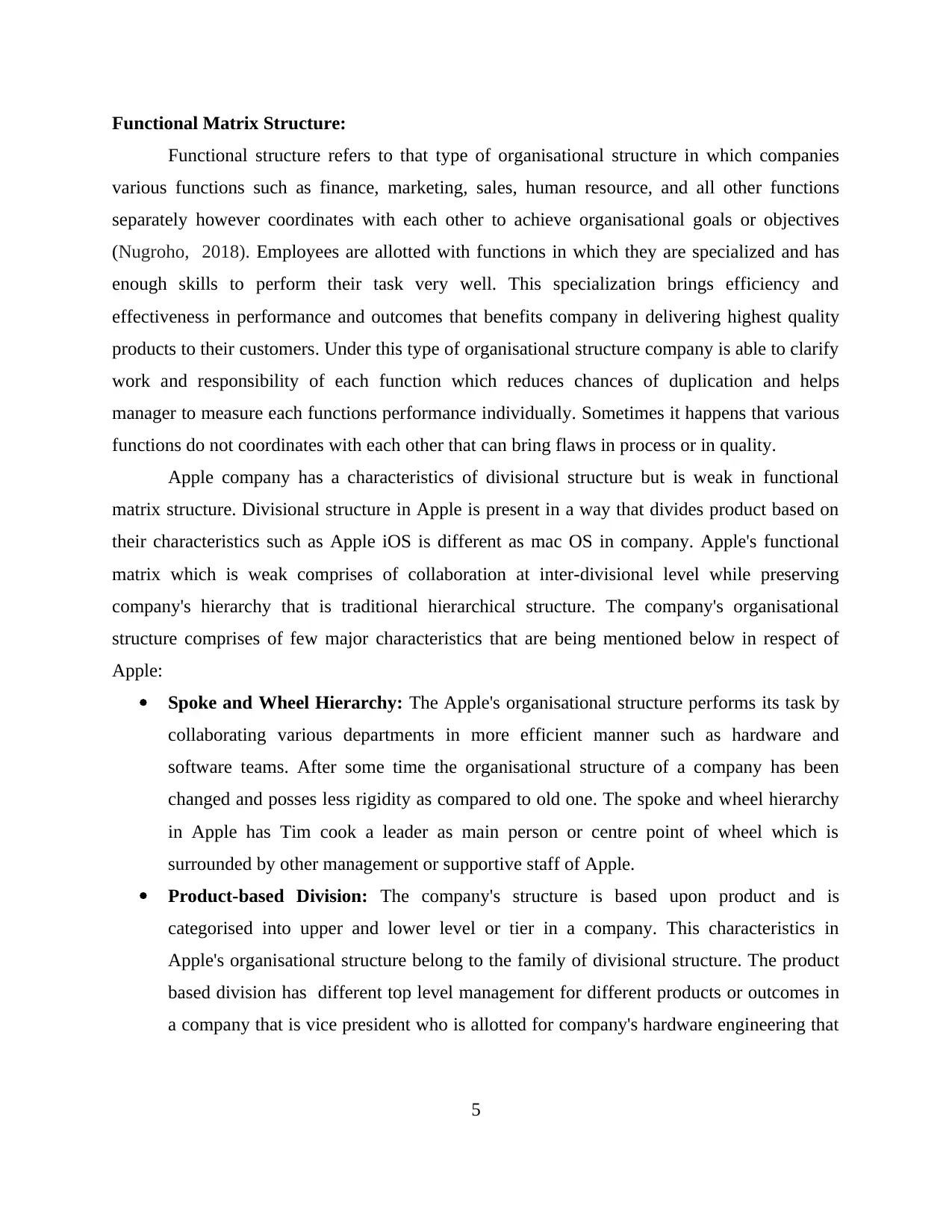
Functional Matrix Structure:
Functional structure refers to that type of organisational structure in which companies
various functions such as finance, marketing, sales, human resource, and all other functions
separately however coordinates with each other to achieve organisational goals or objectives
(Nugroho, 2018). Employees are allotted with functions in which they are specialized and has
enough skills to perform their task very well. This specialization brings efficiency and
effectiveness in performance and outcomes that benefits company in delivering highest quality
products to their customers. Under this type of organisational structure company is able to clarify
work and responsibility of each function which reduces chances of duplication and helps
manager to measure each functions performance individually. Sometimes it happens that various
functions do not coordinates with each other that can bring flaws in process or in quality.
Apple company has a characteristics of divisional structure but is weak in functional
matrix structure. Divisional structure in Apple is present in a way that divides product based on
their characteristics such as Apple iOS is different as mac OS in company. Apple's functional
matrix which is weak comprises of collaboration at inter-divisional level while preserving
company's hierarchy that is traditional hierarchical structure. The company's organisational
structure comprises of few major characteristics that are being mentioned below in respect of
Apple:
Spoke and Wheel Hierarchy: The Apple's organisational structure performs its task by
collaborating various departments in more efficient manner such as hardware and
software teams. After some time the organisational structure of a company has been
changed and posses less rigidity as compared to old one. The spoke and wheel hierarchy
in Apple has Tim cook a leader as main person or centre point of wheel which is
surrounded by other management or supportive staff of Apple.
Product-based Division: The company's structure is based upon product and is
categorised into upper and lower level or tier in a company. This characteristics in
Apple's organisational structure belong to the family of divisional structure. The product
based division has different top level management for different products or outcomes in
a company that is vice president who is allotted for company's hardware engineering that
5
Functional structure refers to that type of organisational structure in which companies
various functions such as finance, marketing, sales, human resource, and all other functions
separately however coordinates with each other to achieve organisational goals or objectives
(Nugroho, 2018). Employees are allotted with functions in which they are specialized and has
enough skills to perform their task very well. This specialization brings efficiency and
effectiveness in performance and outcomes that benefits company in delivering highest quality
products to their customers. Under this type of organisational structure company is able to clarify
work and responsibility of each function which reduces chances of duplication and helps
manager to measure each functions performance individually. Sometimes it happens that various
functions do not coordinates with each other that can bring flaws in process or in quality.
Apple company has a characteristics of divisional structure but is weak in functional
matrix structure. Divisional structure in Apple is present in a way that divides product based on
their characteristics such as Apple iOS is different as mac OS in company. Apple's functional
matrix which is weak comprises of collaboration at inter-divisional level while preserving
company's hierarchy that is traditional hierarchical structure. The company's organisational
structure comprises of few major characteristics that are being mentioned below in respect of
Apple:
Spoke and Wheel Hierarchy: The Apple's organisational structure performs its task by
collaborating various departments in more efficient manner such as hardware and
software teams. After some time the organisational structure of a company has been
changed and posses less rigidity as compared to old one. The spoke and wheel hierarchy
in Apple has Tim cook a leader as main person or centre point of wheel which is
surrounded by other management or supportive staff of Apple.
Product-based Division: The company's structure is based upon product and is
categorised into upper and lower level or tier in a company. This characteristics in
Apple's organisational structure belong to the family of divisional structure. The product
based division has different top level management for different products or outcomes in
a company that is vice president who is allotted for company's hardware engineering that
5
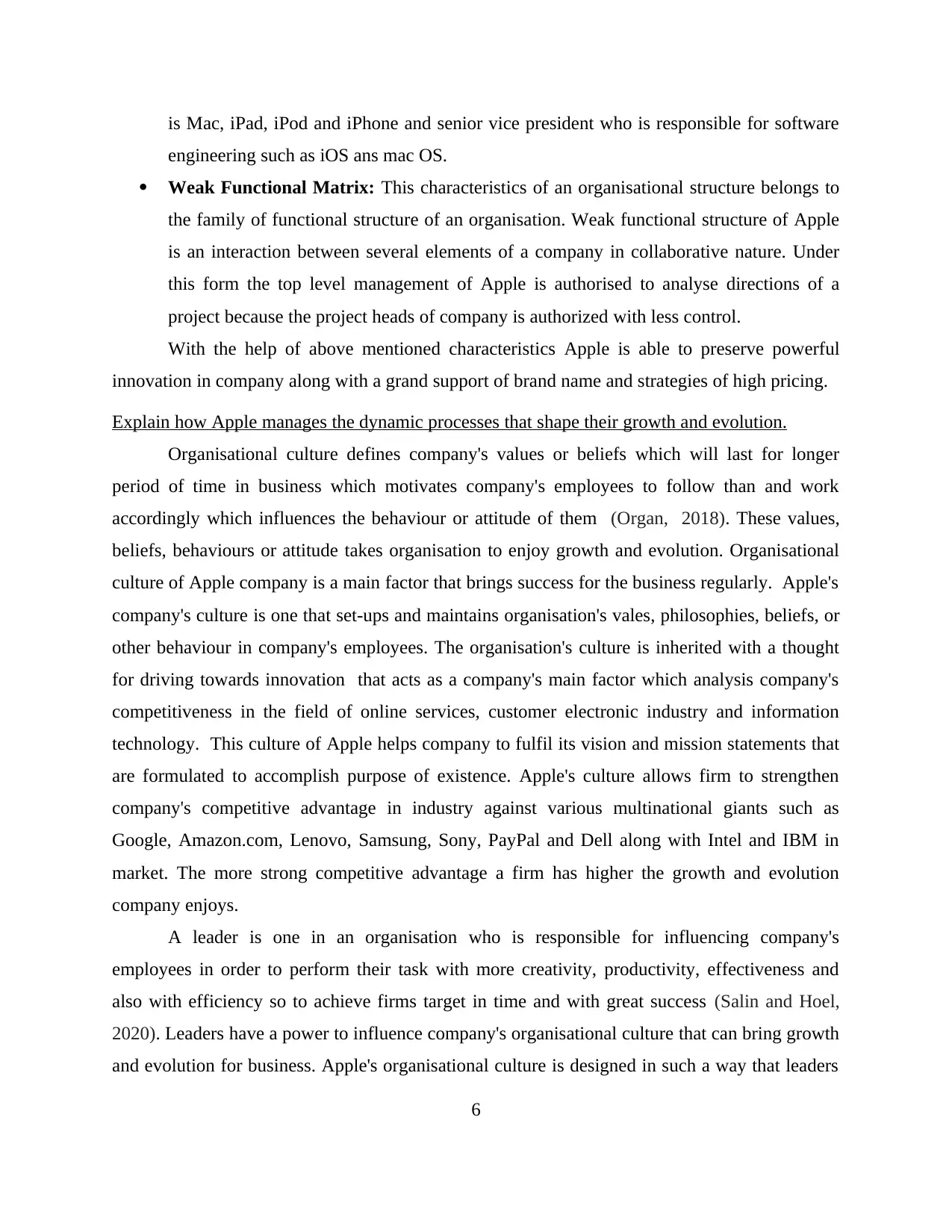
is Mac, iPad, iPod and iPhone and senior vice president who is responsible for software
engineering such as iOS ans mac OS.
Weak Functional Matrix: This characteristics of an organisational structure belongs to
the family of functional structure of an organisation. Weak functional structure of Apple
is an interaction between several elements of a company in collaborative nature. Under
this form the top level management of Apple is authorised to analyse directions of a
project because the project heads of company is authorized with less control.
With the help of above mentioned characteristics Apple is able to preserve powerful
innovation in company along with a grand support of brand name and strategies of high pricing.
Explain how Apple manages the dynamic processes that shape their growth and evolution.
Organisational culture defines company's values or beliefs which will last for longer
period of time in business which motivates company's employees to follow than and work
accordingly which influences the behaviour or attitude of them (Organ, 2018). These values,
beliefs, behaviours or attitude takes organisation to enjoy growth and evolution. Organisational
culture of Apple company is a main factor that brings success for the business regularly. Apple's
company's culture is one that set-ups and maintains organisation's vales, philosophies, beliefs, or
other behaviour in company's employees. The organisation's culture is inherited with a thought
for driving towards innovation that acts as a company's main factor which analysis company's
competitiveness in the field of online services, customer electronic industry and information
technology. This culture of Apple helps company to fulfil its vision and mission statements that
are formulated to accomplish purpose of existence. Apple's culture allows firm to strengthen
company's competitive advantage in industry against various multinational giants such as
Google, Amazon.com, Lenovo, Samsung, Sony, PayPal and Dell along with Intel and IBM in
market. The more strong competitive advantage a firm has higher the growth and evolution
company enjoys.
A leader is one in an organisation who is responsible for influencing company's
employees in order to perform their task with more creativity, productivity, effectiveness and
also with efficiency so to achieve firms target in time and with great success (Salin and Hoel,
2020). Leaders have a power to influence company's organisational culture that can bring growth
and evolution for business. Apple's organisational culture is designed in such a way that leaders
6
engineering such as iOS ans mac OS.
Weak Functional Matrix: This characteristics of an organisational structure belongs to
the family of functional structure of an organisation. Weak functional structure of Apple
is an interaction between several elements of a company in collaborative nature. Under
this form the top level management of Apple is authorised to analyse directions of a
project because the project heads of company is authorized with less control.
With the help of above mentioned characteristics Apple is able to preserve powerful
innovation in company along with a grand support of brand name and strategies of high pricing.
Explain how Apple manages the dynamic processes that shape their growth and evolution.
Organisational culture defines company's values or beliefs which will last for longer
period of time in business which motivates company's employees to follow than and work
accordingly which influences the behaviour or attitude of them (Organ, 2018). These values,
beliefs, behaviours or attitude takes organisation to enjoy growth and evolution. Organisational
culture of Apple company is a main factor that brings success for the business regularly. Apple's
company's culture is one that set-ups and maintains organisation's vales, philosophies, beliefs, or
other behaviour in company's employees. The organisation's culture is inherited with a thought
for driving towards innovation that acts as a company's main factor which analysis company's
competitiveness in the field of online services, customer electronic industry and information
technology. This culture of Apple helps company to fulfil its vision and mission statements that
are formulated to accomplish purpose of existence. Apple's culture allows firm to strengthen
company's competitive advantage in industry against various multinational giants such as
Google, Amazon.com, Lenovo, Samsung, Sony, PayPal and Dell along with Intel and IBM in
market. The more strong competitive advantage a firm has higher the growth and evolution
company enjoys.
A leader is one in an organisation who is responsible for influencing company's
employees in order to perform their task with more creativity, productivity, effectiveness and
also with efficiency so to achieve firms target in time and with great success (Salin and Hoel,
2020). Leaders have a power to influence company's organisational culture that can bring growth
and evolution for business. Apple's organisational culture is designed in such a way that leaders
6
⊘ This is a preview!⊘
Do you want full access?
Subscribe today to unlock all pages.

Trusted by 1+ million students worldwide
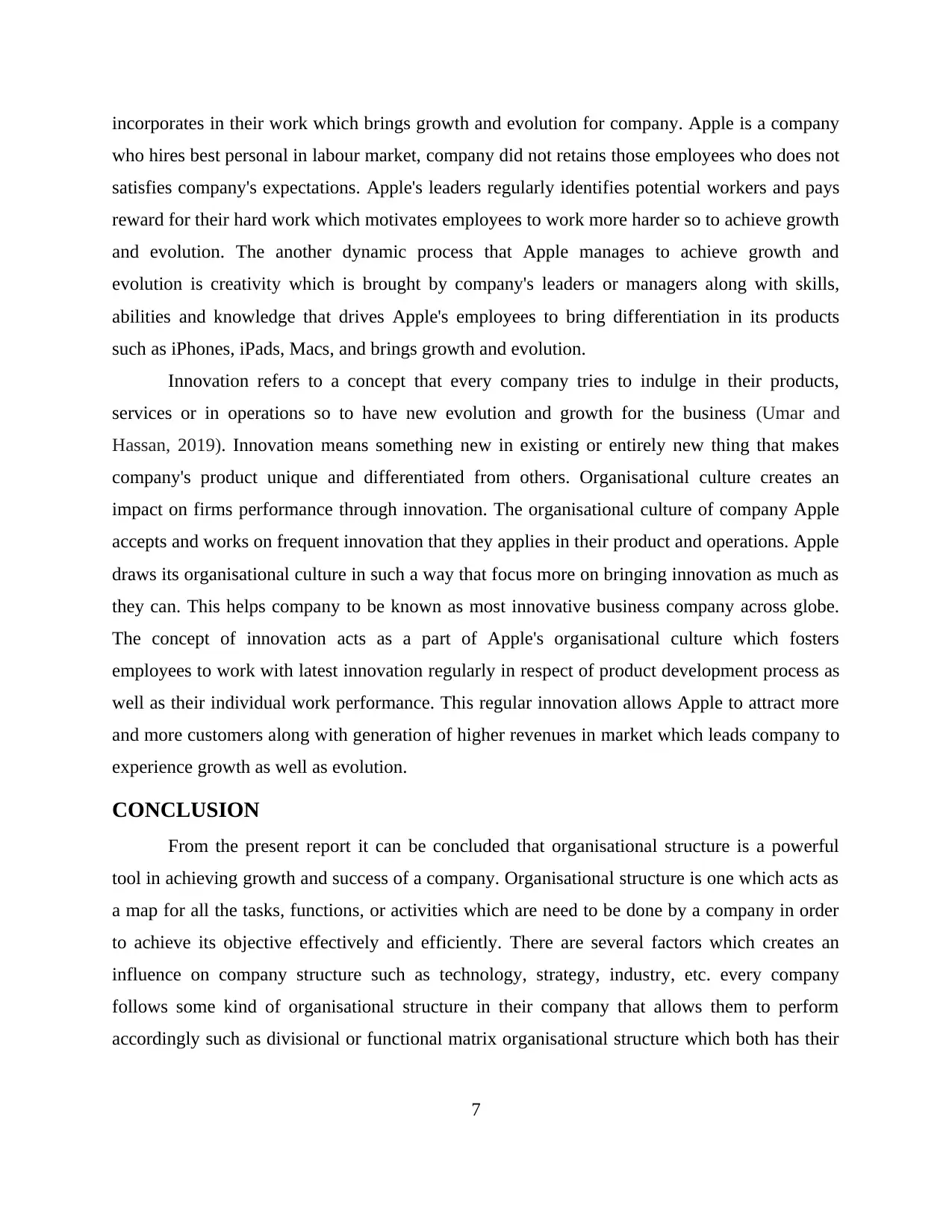
incorporates in their work which brings growth and evolution for company. Apple is a company
who hires best personal in labour market, company did not retains those employees who does not
satisfies company's expectations. Apple's leaders regularly identifies potential workers and pays
reward for their hard work which motivates employees to work more harder so to achieve growth
and evolution. The another dynamic process that Apple manages to achieve growth and
evolution is creativity which is brought by company's leaders or managers along with skills,
abilities and knowledge that drives Apple's employees to bring differentiation in its products
such as iPhones, iPads, Macs, and brings growth and evolution.
Innovation refers to a concept that every company tries to indulge in their products,
services or in operations so to have new evolution and growth for the business (Umar and
Hassan, 2019). Innovation means something new in existing or entirely new thing that makes
company's product unique and differentiated from others. Organisational culture creates an
impact on firms performance through innovation. The organisational culture of company Apple
accepts and works on frequent innovation that they applies in their product and operations. Apple
draws its organisational culture in such a way that focus more on bringing innovation as much as
they can. This helps company to be known as most innovative business company across globe.
The concept of innovation acts as a part of Apple's organisational culture which fosters
employees to work with latest innovation regularly in respect of product development process as
well as their individual work performance. This regular innovation allows Apple to attract more
and more customers along with generation of higher revenues in market which leads company to
experience growth as well as evolution.
CONCLUSION
From the present report it can be concluded that organisational structure is a powerful
tool in achieving growth and success of a company. Organisational structure is one which acts as
a map for all the tasks, functions, or activities which are need to be done by a company in order
to achieve its objective effectively and efficiently. There are several factors which creates an
influence on company structure such as technology, strategy, industry, etc. every company
follows some kind of organisational structure in their company that allows them to perform
accordingly such as divisional or functional matrix organisational structure which both has their
7
who hires best personal in labour market, company did not retains those employees who does not
satisfies company's expectations. Apple's leaders regularly identifies potential workers and pays
reward for their hard work which motivates employees to work more harder so to achieve growth
and evolution. The another dynamic process that Apple manages to achieve growth and
evolution is creativity which is brought by company's leaders or managers along with skills,
abilities and knowledge that drives Apple's employees to bring differentiation in its products
such as iPhones, iPads, Macs, and brings growth and evolution.
Innovation refers to a concept that every company tries to indulge in their products,
services or in operations so to have new evolution and growth for the business (Umar and
Hassan, 2019). Innovation means something new in existing or entirely new thing that makes
company's product unique and differentiated from others. Organisational culture creates an
impact on firms performance through innovation. The organisational culture of company Apple
accepts and works on frequent innovation that they applies in their product and operations. Apple
draws its organisational culture in such a way that focus more on bringing innovation as much as
they can. This helps company to be known as most innovative business company across globe.
The concept of innovation acts as a part of Apple's organisational culture which fosters
employees to work with latest innovation regularly in respect of product development process as
well as their individual work performance. This regular innovation allows Apple to attract more
and more customers along with generation of higher revenues in market which leads company to
experience growth as well as evolution.
CONCLUSION
From the present report it can be concluded that organisational structure is a powerful
tool in achieving growth and success of a company. Organisational structure is one which acts as
a map for all the tasks, functions, or activities which are need to be done by a company in order
to achieve its objective effectively and efficiently. There are several factors which creates an
influence on company structure such as technology, strategy, industry, etc. every company
follows some kind of organisational structure in their company that allows them to perform
accordingly such as divisional or functional matrix organisational structure which both has their
7
Paraphrase This Document
Need a fresh take? Get an instant paraphrase of this document with our AI Paraphraser
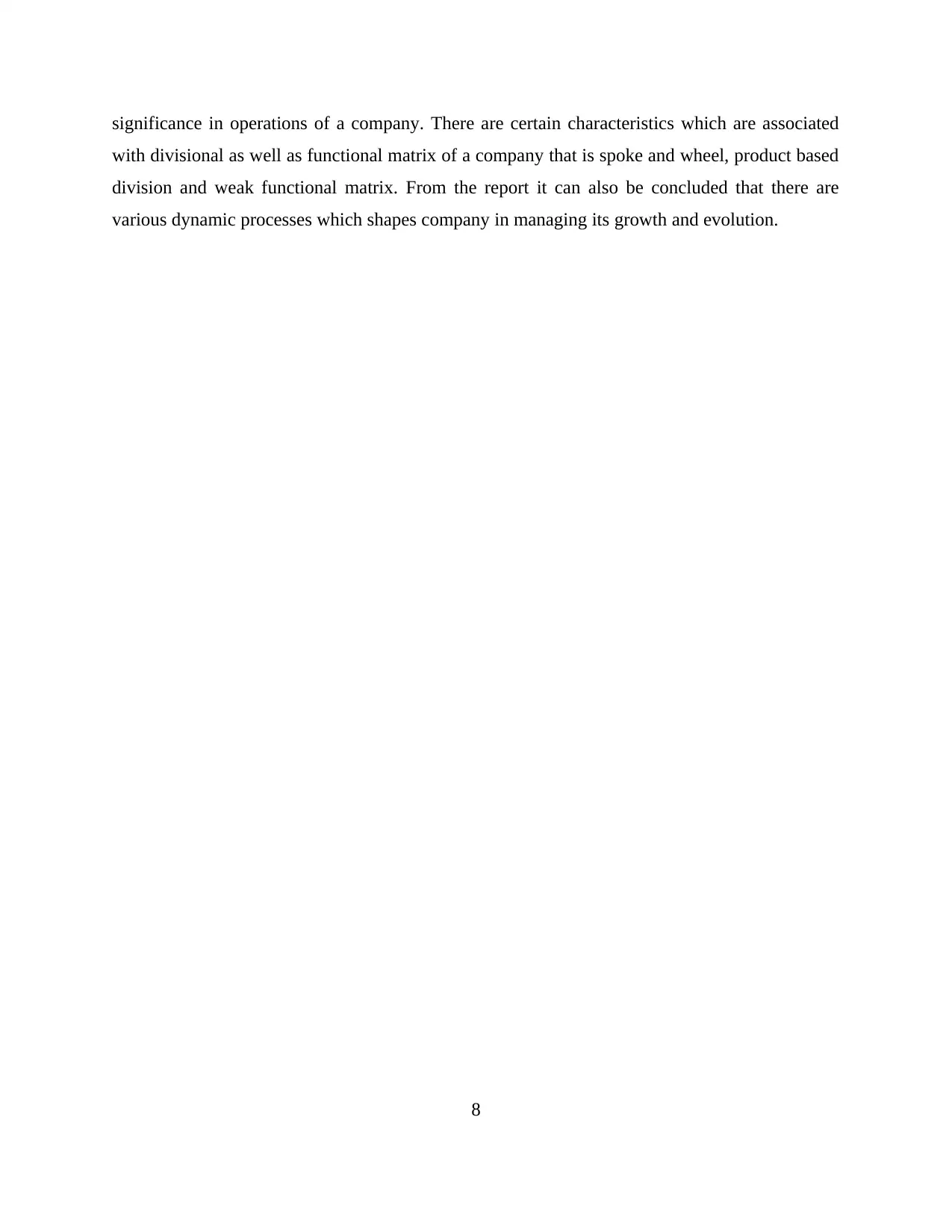
significance in operations of a company. There are certain characteristics which are associated
with divisional as well as functional matrix of a company that is spoke and wheel, product based
division and weak functional matrix. From the report it can also be concluded that there are
various dynamic processes which shapes company in managing its growth and evolution.
8
with divisional as well as functional matrix of a company that is spoke and wheel, product based
division and weak functional matrix. From the report it can also be concluded that there are
various dynamic processes which shapes company in managing its growth and evolution.
8
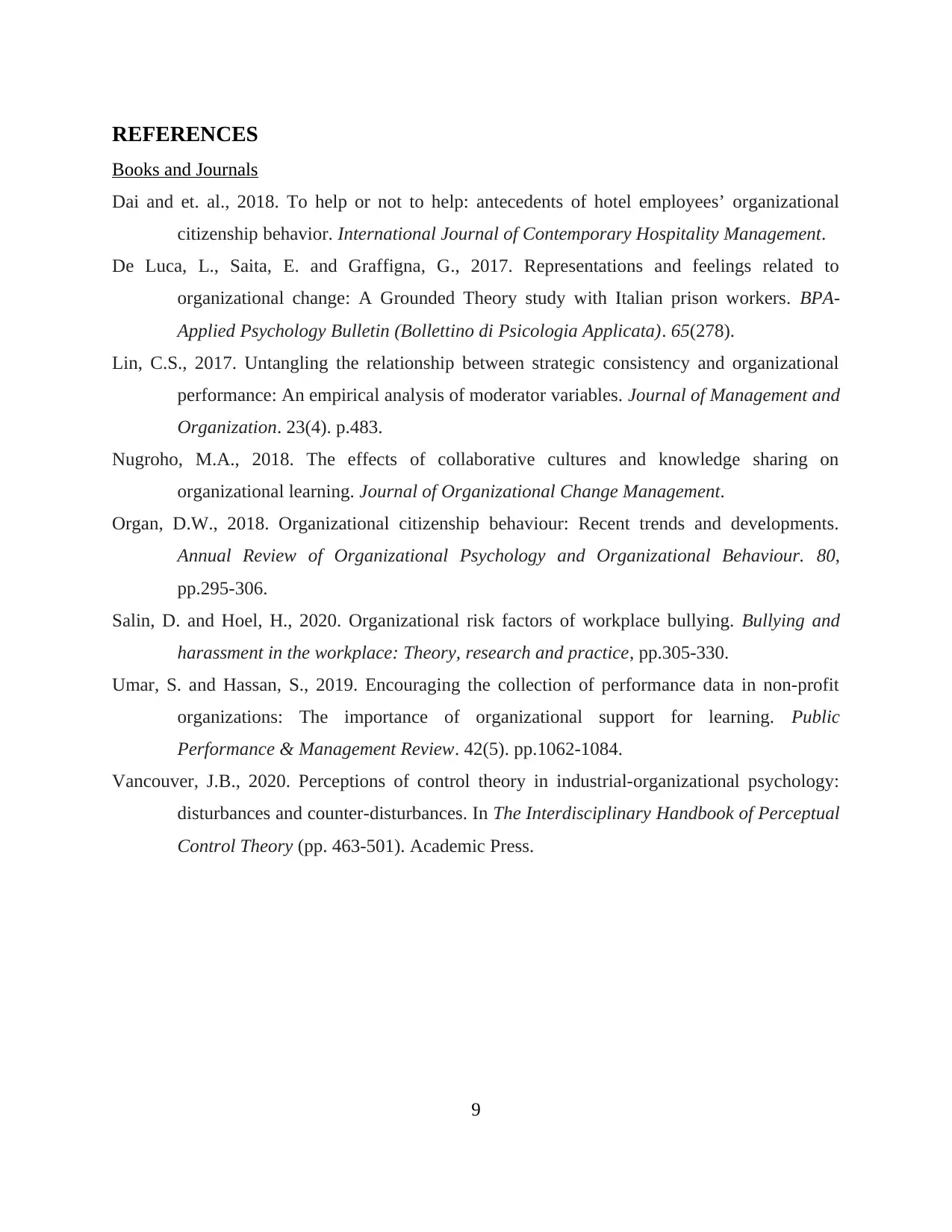
REFERENCES
Books and Journals
Dai and et. al., 2018. To help or not to help: antecedents of hotel employees’ organizational
citizenship behavior. International Journal of Contemporary Hospitality Management.
De Luca, L., Saita, E. and Graffigna, G., 2017. Representations and feelings related to
organizational change: A Grounded Theory study with Italian prison workers. BPA-
Applied Psychology Bulletin (Bollettino di Psicologia Applicata). 65(278).
Lin, C.S., 2017. Untangling the relationship between strategic consistency and organizational
performance: An empirical analysis of moderator variables. Journal of Management and
Organization. 23(4). p.483.
Nugroho, M.A., 2018. The effects of collaborative cultures and knowledge sharing on
organizational learning. Journal of Organizational Change Management.
Organ, D.W., 2018. Organizational citizenship behaviour: Recent trends and developments.
Annual Review of Organizational Psychology and Organizational Behaviour. 80,
pp.295-306.
Salin, D. and Hoel, H., 2020. Organizational risk factors of workplace bullying. Bullying and
harassment in the workplace: Theory, research and practice, pp.305-330.
Umar, S. and Hassan, S., 2019. Encouraging the collection of performance data in non-profit
organizations: The importance of organizational support for learning. Public
Performance & Management Review. 42(5). pp.1062-1084.
Vancouver, J.B., 2020. Perceptions of control theory in industrial-organizational psychology:
disturbances and counter-disturbances. In The Interdisciplinary Handbook of Perceptual
Control Theory (pp. 463-501). Academic Press.
9
Books and Journals
Dai and et. al., 2018. To help or not to help: antecedents of hotel employees’ organizational
citizenship behavior. International Journal of Contemporary Hospitality Management.
De Luca, L., Saita, E. and Graffigna, G., 2017. Representations and feelings related to
organizational change: A Grounded Theory study with Italian prison workers. BPA-
Applied Psychology Bulletin (Bollettino di Psicologia Applicata). 65(278).
Lin, C.S., 2017. Untangling the relationship between strategic consistency and organizational
performance: An empirical analysis of moderator variables. Journal of Management and
Organization. 23(4). p.483.
Nugroho, M.A., 2018. The effects of collaborative cultures and knowledge sharing on
organizational learning. Journal of Organizational Change Management.
Organ, D.W., 2018. Organizational citizenship behaviour: Recent trends and developments.
Annual Review of Organizational Psychology and Organizational Behaviour. 80,
pp.295-306.
Salin, D. and Hoel, H., 2020. Organizational risk factors of workplace bullying. Bullying and
harassment in the workplace: Theory, research and practice, pp.305-330.
Umar, S. and Hassan, S., 2019. Encouraging the collection of performance data in non-profit
organizations: The importance of organizational support for learning. Public
Performance & Management Review. 42(5). pp.1062-1084.
Vancouver, J.B., 2020. Perceptions of control theory in industrial-organizational psychology:
disturbances and counter-disturbances. In The Interdisciplinary Handbook of Perceptual
Control Theory (pp. 463-501). Academic Press.
9
⊘ This is a preview!⊘
Do you want full access?
Subscribe today to unlock all pages.

Trusted by 1+ million students worldwide
1 out of 9
Related Documents
Your All-in-One AI-Powered Toolkit for Academic Success.
+13062052269
info@desklib.com
Available 24*7 on WhatsApp / Email
![[object Object]](/_next/static/media/star-bottom.7253800d.svg)
Unlock your academic potential
Copyright © 2020–2025 A2Z Services. All Rights Reserved. Developed and managed by ZUCOL.





